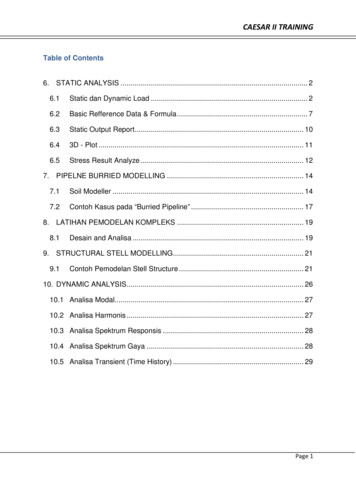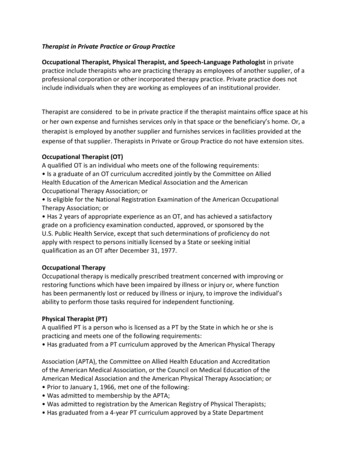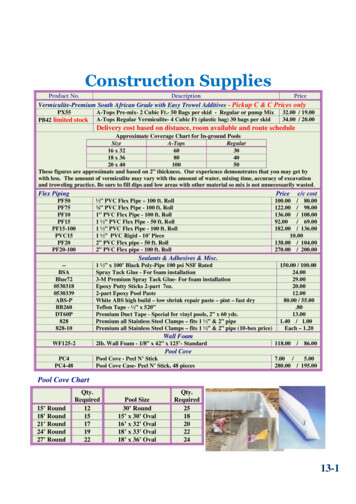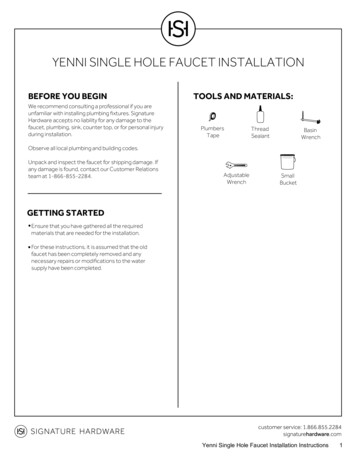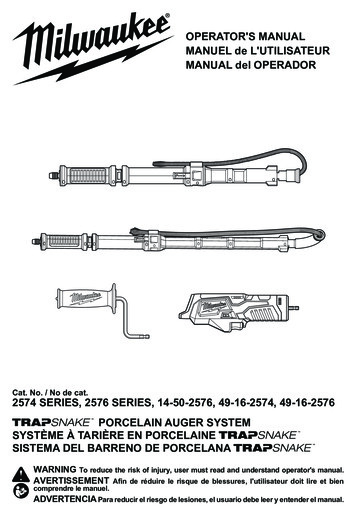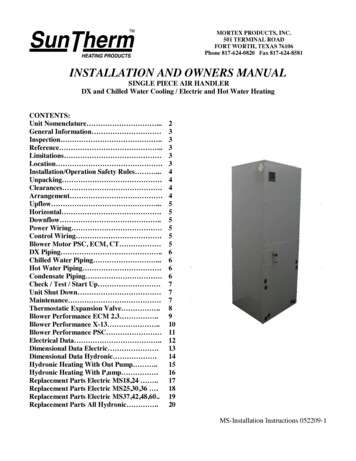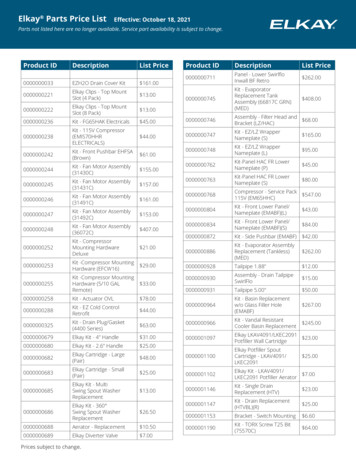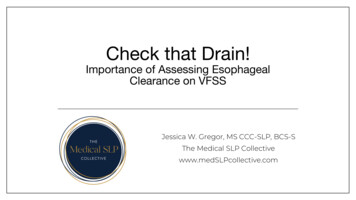
Transcription
Check that Drain!Importance of Assessing EsophagealClearance on VFSSJessica W. Gregor, MS CCC-SLP, BCS-SThe Medical SLP Collectivewww.medSLPcollective.com
Disclosure StatementsFinancial: Receives salary from Mayo Clinic Arizona Employed by Florida Dysphagia Institute, LLC Receives honorarium for this presentationFinancial: Creator of Instagram page @the swallow nerd
A Little About Me Practicing for over a decade in both private sector VA academic-medical institutions BS in Speech and Hearing Science from University of Illinois at Urbana-Champaign MS in Communication Sciences and Disorders from Rush University in Chicago Board Certified Specialist in Adult Swallowing and Swallowing Disorders since 2016 Served on the ABSSD Mentorship Committee 2018-2020; continue to mentor FDI Faculty and McNeill Dysphagia Therapy Program instructor since 2019 Populations of interest: HNC/TL, cardiopulmonary disease, reflux disease
Swallowing: The Big PictureOral PhasePharyngealPhaseGraphic representation of the swallow process created/generated by the author of this presentationEsophagealPhase
The Pharyngoesophageal SegmentKidney-shaped, comprised of: Inferior pharyngeal constrictor Cricopharyngeus muscle Upper most part of the circular esophageal musculatureFunction: Prevent aerophagia when speaking/eating Protect airway from regurgitated esophageal/gastric contentsBelafsky, 2020 with permissionTelltale of disorder! Look above AND below for cause! Look above AND below for compensation or decompensation!Jones (1985)
The Infamous InterplayUnbreakable relationship between the oropharynx esophagus Airway protection mechanics (reflexes)A disturbance in any part of the swallowing continuum can cause adisruption in any or all aspects of swallowing Disruptions can be adaptive or compensatory Treatment for OP may have impact on E and vice versaReedy et al. (2021)
Protective exivePharyngealSwallowEsophagoGlottal ClosureReflexPharyngoGlottal talsisDua et al. (2014); Jadcherla et al. (2010); Shaker (2006)
Upstream & Downstream EffectsGullung et al., 2012Miles et al., 2015O’Rourke et al.,2014Triadafilopoulus etal., 1992Radiographic image from author’s personal collection Abnormal esophageal function canimpact swallow initiation timing Oral abnormalities and reduced PESopening are associated with esophagealabnormalities Voluntary swallow maneuvers impactesophageal peristalsis Oropharyngeal function is significantlyaltered in those with esophageal motilitydisorders and vice versaProximal Referral
When the Drain Isn’t Checked LOOK DOWN!Huffman, 2015 (with permission)1234RISKMISDIAGNOSISEMPLOYINEFFECTIVE TXWASTERESOURCESPATIENTFRUSTRATIONRadiographic images from author’s personal collection
What about validatedprotocols for the esophagus?
Watts et al. (2021) with permission
RESTRobust Esophageal Screening TestValidated protocol of esophageal function during VFSS 4 trials: solid, E-Z-PAQUE, and 12.7 mm barium tabletOperational definitions: Normal Anatomic abnormality DysmotilityPass/Fail but descriptive to inform best referral/interventionHigh diagnostic yieldWatts et al. (2021)Stephanie Watts, PhD, CCC-SLP
REST: Pass1. Solid PASS2. Liquid #1 PASS3. Liquid #2 PASS4. Pill PASSRadiographic image from author’s personal collection
REST: FailDysmotility & Anatomic Abnormality1. Solid PASS2. Liquid #1 FAIL3. Liquid #2 FAIL4. Pill PASSRadiographic image from author’s personal collection
REST: FailDysmotility & Anatomic Abnormality1. Solid FAIL2. Liquid #1 FAIL3. Liquid #2 FAIL4. Pill FAILRadiographic image from author’s personal collection
Bottom LineTHE COMPLETE SWALLOW CHAIN SHOULD BE ASSESSED DURING FLUORO!Esophagus may hold missing piece to your patient’s complaintsMultiphase dysphagia may be present with simultaneous impairmentsFindings inform next step/referral or best interventionUse a validated protocolAllen et al. (2012); Jones et al. (1985); Watts et al. (2020); Watts et al. (2021)
52.61% agreed33.73% disagreed13.65% NeutralWatts, S. (2022). The modified barium swallow study and esophageal screening: A survey of clinical practice patterns. [Manuscript submitted for publication] with permission
Questions?Graphic provided by MedSLP Summit as part of their dedicated power point template
ReferencesAllen, J., White, C., Leonard, R. & Belafsky, P. (2012). Comparison of esophageal screen findings on videofluoroscopy with full esophagramresults. Head Neck, 34(2): 264-269. doi: 10.1002/hed.21727Belafsky, P., Rees, C., Allen, J., & Leonard, R. (2010). Pharyngeal dilation in cricopharyngeus muscle dysfunction and Zenker diverticulum.Laryngoscope, 120(5): 889-94. doi: 10.1002/lary.20874Dua, K., Surapaneni, S., Kuribayashi, S., Hafeezullah, M., & Shaker, R. (2014). Effect of aging on hypopharyngeal safe volume and theaerodigestive reflexes protecting the airways. Laryngoscope, 124(8): 1862–1868. doi: 10.1002/lary.24539Falcao, A., Nasi, A., Brandao, J., Sallum, R., & Cecconello, I. (2013). What is the real impairment on esophageal motility in patients withgastroesophageal reflux disease. Arq Gastroenterol, 50(2): 111-116. doi: 10.1590/s0004-28032013000200019Griffiths, T., Nassar, M., & Soubani, A. (2020). Pulmonary manifestations of gastroesophageal reflux disease. Expert Rev Respir Med, 14(8): 767775. doi: 10.1080/17476348.2020.1758068Gullung, J., Hill, E., Castell, D., & Martin-Harris, B. (2012). Oropharyngeal and esophageal swallowing impairments: Their association and thepredictive value of the modified barium swallow impairment profile and combined multichannel intraluminal impedance-esophagealmanometry. Ann Otol Rhinol Laryngol, 121(11): 738-45. doi: 10.1177/000348941212101107Jadcherla, S., Hogan, W., & Shaker, R. (2010). Physiology and pathophysiology of glottic reflexes and pulmonary aspiration: From neonates toadults. Seminars in Respiratory and Critical Care Medicine, 31(5), 554–560. doi: 10.1055/s-0030-1265896
ReferencesJones, B., Ravich, W., Donner, M., Kramer, S., & Hendrix, T. (1985). Pharyngoesophageal interrelationships: Observations and working concepts.Gastrointest Radiol, 10(3): 225-33. doi: 10.1007/BF01893105Kang, C., Zhang, N, & Lott D. (2021). Muscle tension dysphagia: Contributing factors and treatment efficacy. Ann Otol Rhinol Laryngol, 130(7):674-681. doi: 10.1177/0003489420966339Madhavan, A., Carnaby, G., & Crary, M. (2015). 'Food sticking in my throat’: Videofluoroscopic evaluation of a common symptom. Dysphagia,30(3): 343-8. doi: 10.1007/s00455-015-9605-6Mendell, D. & Logemann, J. (2002). A retrospective analysis of the pharyngeal swallow in patients with a clinical diagnosis of GERD comparedwith normal controls: A pilot study. Dysphagia, 17(3), 220–226. doi: 10.1007/s00455-002-0056-5Miles, A., McMillan, J., Ward, K., & Allen, J. (2015). Esophageal visualization as an adjunct to the videofluoroscopic study of swallowing.Otolaryngology-Head and Neck Surgery, 152(3), 488-493. doi: 10.1177/0194599814565599O’Rourke, A., Morgan, L., Coss-Adame, E., Morrison, M., Weinberger, P., & Postma, G. (2014). The effect of voluntary pharyngeal swallowingmaneuvers on esophageal swallowing physiology. Dysphagia, 29(2), 262-268. doi: 10.1007/s00455-013-9505-6Reedy, E., Herbert, T., & Bonilha, H. (2021). Visualizing the esophagus during modified barium swallow studies: A systematic review. AmericanJournal of Speech Language Pathology, 30(2): 761-771. doi: 10.1044/2020 AJSLP-20-00255
ReferencesRoeder, B., Murray, J. & Dierkhising, R. (2004). Patient localization of esophageal dysphagia. Dig Dis Sci, 49: 697–701. doi:10.1023/B:DDAS.0000026321.02927.39Shaker, R. (2006). Reflex interaction of pharynx, esophagus, and airways. GI Motility Online. doi: 10.1038/gimo11Smith, D., Ott, D., Gelfand, D., & Chen, M. (1998). Lower esophageal mucosal ring: Correlation of referred symptoms with radiographic findingsusing a marshmallow bolus. American Journal of Roentgenology, 171(5): 1361-1356. doi: 10.2214/ajr.171.5.9798879Triadafilopoulos, G., Hallstone, A., Nelson-Abbott, H., & Bedinger, K. (1992). Oropharyngeal and esophageal interrelationships in patients withnonobstructive dysphagia. Digestive Diseases and Sciences, 37(4): 551-557. doi: 10.1007/BF01307579Watts, S., Gaziano, J., Kumar, A., & Richter, J. (2021). Diagnostic accuracy of an esophageal screening protocol interpreted by the speechlanguage pathologist. Dysphagia, 36(6), 1063-1071. doi: 10.1007/s00455-020-10239-3Watts, S., Garand, K., & Scheidler, R. (2020). Raising dysphagia awareness requires recognition of multiphase dysphagia. Dysphagia phase-dysphagia/Wilcox, C., Alexander, L., & Clark, W. (1995). Localization of an obstructing esophageal lesion. Is the patient accurate? Dig Dis Sci, 40(10): 21926. doi: 10.1007/BF02209005
FDI Faculty and McNeill Dysphagia Therapy Program instructor since 2019 Populations of interest: HNC/TL, cardiopulmonary disease, reflux disease. Oral Phase Pharyngeal Phase Esophageal Phase Swallowing: The Big Picture . Dysphagia, 36(6), 1063-1071. doi: 10.1007/s00455-020-10239-3

